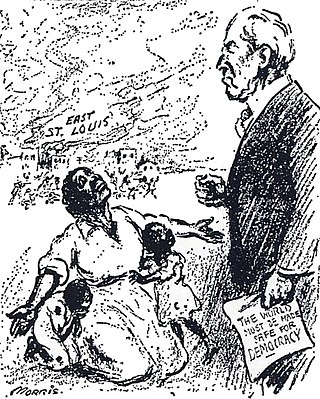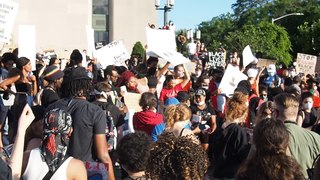In the broader context of racism in the United States, mass racial violence in the United States consists of ethnic conflicts and race riots, along with such events as:

The New York City draft riots, sometimes referred to as the Manhattan draft riots and known at the time as Draft Week, were violent disturbances in Lower Manhattan, widely regarded as the culmination of working-class discontent with new laws passed by Congress that year to draft men to fight in the ongoing American Civil War. The riots remain the largest civil urban disturbance in American history. According to Toby Joyce, the riot represented a "civil war" within the city's Irish community, in that "mostly Irish American rioters confronted police, [while] soldiers, and pro-war politicians ... were also to a considerable extent from the local Irish immigrant community."

The Watts riots, sometimes referred to as the Watts Rebellion or Watts Uprising, took place in the Watts neighborhood and its surrounding areas of Los Angeles from August 11 to 16, 1965. The riots were motivated by anger at the racist and abusive practices of the Los Angeles Police Department, as well as grievances over employment discrimination, residential segregation, and poverty in L.A.

Bloody Sunday was an event which took place in London, England on 13 November 1887, when a crowd of marchers protesting about unemployment and the Irish Coercion Acts, as well as demanding the release of MP William O'Brien, clashed with the Metropolitan Police. The demonstration was organised by the Social Democratic Federation and the Irish National League. Violent clashes took place between the police and demonstrators, many "armed with iron bars, knives, pokers and gas pipes". A contemporary report noted that 400 were arrested and 75 people were badly injured, including many police, two policemen being stabbed and one protester bayonetted.

Tompkins Square Park is a 10.5-acre (4.2 ha) public park in the Alphabet City portion of East Village, Manhattan, New York City. The square-shaped park, bounded on the north by East 10th Street, on the east by Avenue B, on the south by East 7th Street, and on the west by Avenue A, is abutted by St. Marks Place to the west. The park opened in 1834 and is named for Daniel D. Tompkins, Vice President of the United States.

The East St. Louis massacre was a series of violent attacks between African Americans and white Americans in East St. Louis, Illinois, between late May and early July of 1917. These attacks also displaced 6,000 African Americans and led to the destruction of approximately $400,000 worth of property. They occurred in East St. Louis, an industrial city on the east bank of the Mississippi River, directly opposite the city of St. Louis, Missouri. The July 1917 episode in particular was marked by violence throughout the city. The multi-day rioting has been described as the "worst case of labor-related violence in 20th-century American history", and among the worst racial riots in U.S. history.

The Cleveland May Day riots of 1919 were a series of violent demonstrations that occurred throughout Cleveland, Ohio on May 1, 1919. The riots occurred during the May Day parade organized by Socialist leader Charles Ruthenberg, of local trade unionists, socialists, communists, and the Industrial Workers of the World (IWW) to protest against the conviction of Eugene V. Debs and against American intervention in the Russian Civil War against the Bolsheviks.
The Tompkins Square Park riot occurred on August 6–7, 1988 in Tompkins Square Park, located in the East Village and Alphabet City neighborhoods of Manhattan, New York City. Groups of "drug pushers, homeless people and young people known as squatters and punks," had largely taken over the park. The East Village and Alphabet City communities were divided about what, if anything, should be done about it. The local governing body, Manhattan Community Board 3, recommended, and the New York City Parks Department adopted a 1 a.m. curfew for the previously 24-hour park, in an attempt to bring it under control. On July 31, a protest rally against the curfew saw several clashes between protesters and police.
The 1994 Vancouver Stanley Cup Riot occurred in Downtown Vancouver, British Columbia, Canada, on the evening of June 14, 1994, and continued into the following morning. The riot followed Game 7 of the 1994 Stanley Cup Finals in which the Vancouver Canucks lost to the New York Rangers. It was Vancouver's first riot since 1972, when the Rolling Stones American Tour 1972 led to confrontations between the police and 2,000 outside the Pacific Coliseum.

The Tompkins Square Park riot occurred on January 13, 1874, at Tompkins Square Park in what is now the East Village and Alphabet City neighborhoods of Manhattan, New York City. The riot started after the New York City Police Department clashed with a demonstration involving thousands of unemployed civilians.

The Harlem riot of 1964 was a race riot that occurred between July 16 and 22, 1964 in the New York City neighborhoods of Harlem and Bedford-Stuyvesant, United States. It began after James Powell, a 15-year-old African American, was shot and killed by police Lieutenant Thomas Gilligan in front of Powell's friends and about a dozen other witnesses. Hundreds of students from Powell's school protested the killing. The shooting set off six consecutive nights of rioting. By some accounts, 4,000 people participated in the riots. People attacked the New York City Police Department (NYPD), destroyed property, and looted stores. Several rioters were severely beaten by NYPD officers. The riots and unrest left one dead, 118 injured, and 465 arrested.
The flour riot of 1837 was a food riot that broke out in New York City in February 1837, and lasted less than a day. This violent civil disturbance grew out of a public meeting called by the Locofocos to protest runaway prices, as hungry workers plundered private storerooms filled with sacks of hoarded flour. Commodity prices had skyrocketed over the winter of 1836–37, an inflationary boom fueled by foreign investment and two successive years of wheat crop failures. The riot was also a sign of the impending financial crisis known as the Panic of 1837, that hit the American economy the following month.
A race riot took place in Harlem, New York City, on August 1 and 2 of 1943, after a white police officer, James Collins, shot and wounded Robert Bandy, an African American soldier; and rumors circulated that the soldier had been killed. The riot was chiefly directed by Black residents against white-owned property in Harlem. It was one of five riots in the nation that year related to Black and white tensions during World War II. The others took place in Detroit; Beaumont, Texas; Mobile, Alabama; and Los Angeles.

The Jordanian protests were a series of protests in Jordan that began in January 2011, and resulted in the firing of the cabinet ministers of the government. In its early phase, protests in Jordan were initially against unemployment, inflation, corruption. along with demanding for real constitutional monarchy and electoral reforms.

Marie Ganz (1891–1968) was an anarchist and activist.

George Floyd protests in New York City took place at several sites in each of the five New York City boroughs, starting on May 28, 2020, in reaction to the murder of George Floyd. Most of the protests were peaceful, while some sites experienced protester and/or police violence, including several high-profile incidents of excessive force. Looting became a parallel issue, especially in Manhattan. As a result, and amid the COVID-19 pandemic, the city was placed under curfew from June 1–7, the first curfew in the city since 1943.
The 1967 New York City riot was one of many riots that occurred during the long, hot summer of 1967. The riot began after an off-duty police officer, Patrolman Anthony Cinquemani, while trying to break up a fight, shot and killed a Puerto Rican man named Renaldo Rodriquez who had a knife and lunged toward him.












